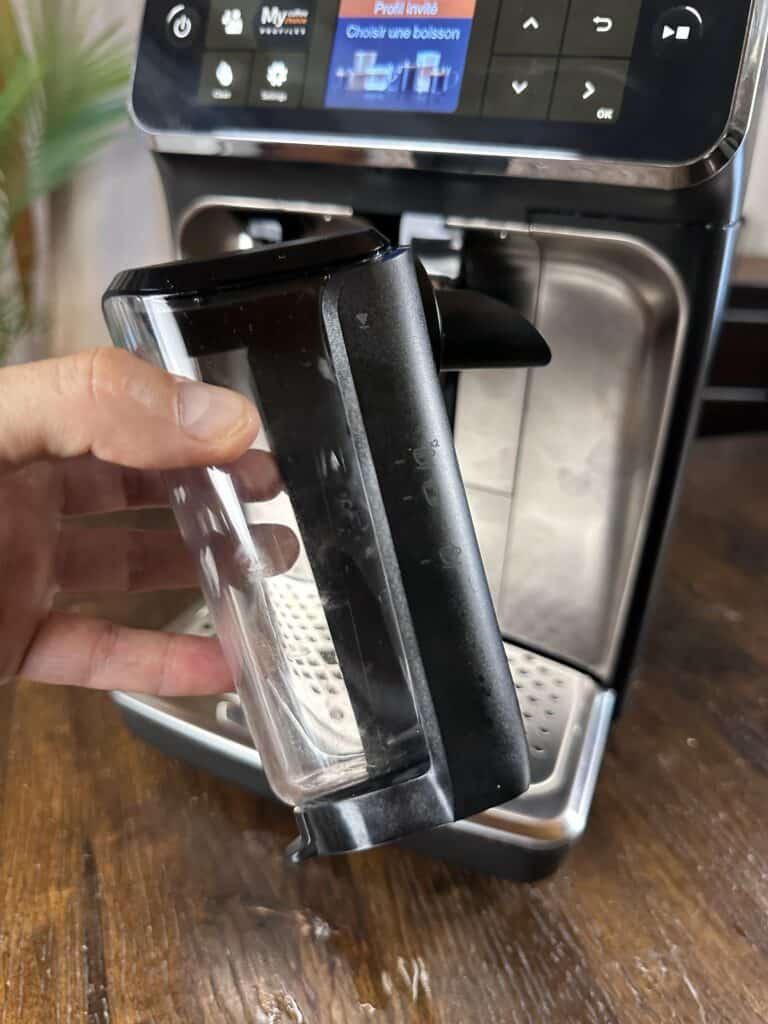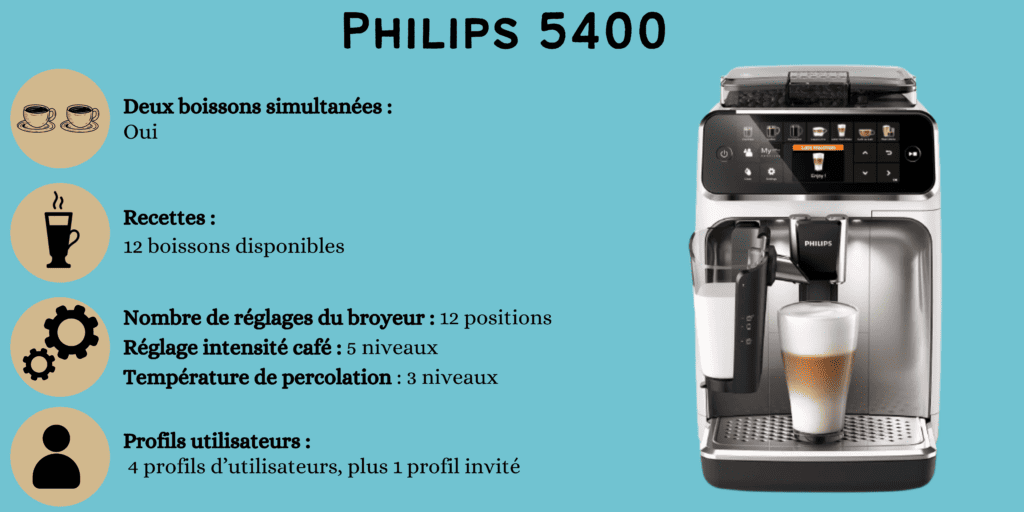
Cappuccino, flat white, latte macchiato, americano or strong espresso, here’s a small selection of the 12 beverages offered by the Philips 5400.
If there’s more than one of you at home, and you’re looking for a coffee maker with an automatic grinder that can satisfy everyone, the machine I’m currently testing should please you. But its simplicity also comes with a few drawbacks.
What does the Latte Go system offer? How good is espresso extraction? Is it a good choice for family use? I’ve just been testing this espresso grinder for several months, making hundreds of coffee and milk drinks.
I put this machine through a battery of tests: here’s my verdict.
The 5400: Philips’ top of the range
You may not be familiar with all the Philips machine ranges. Rest assured, there’s nothing simple to remember.
The 5400 in the Philips range
There are 4 ranges: 2200, 3300, 4300 and 5400. The latter, the one we’re talking about here, is the top of the range for the Philips brand. This means that this machine is the best the brand has to offer.
In fact, if you’re looking for something even more elitist, look no further than the Saeco brand, which belongs to Philips despite its independent name. But now we’re in a different category (including price).
Its LED-lit chrome front panel and touchscreen give it a modern, elegant look that I really like.
Other Philips grain mills
An ideal machine for the family.

On top of the machine is the bean container, which holds 275 grams, perfect for a bag of coffee (usually 250 grams).
The lid is smoked and has a gasket to protect your coffee, which is useful especially with such a large container. So you won’t necessarily need an airtight box on the side. It’s a little touch that I appreciate.


It also has a large 1.8-liter capacity, so you can serve the whole family without having to refill it too regularly.
In the water tank, you’ll find a filter cartridge specific to Philips, the Aquaclean cartridge, which allows you to space out your descaling. As you know, I always recommend filtering your water.
The Philips 5400 offers large containers for a machine of this size, perfect for families or large coffee consumers.
Up to 4 user profiles and one guest profile are also possible. They’re easy to select on the touchscreen interface, which I’ll explain in detail later in this review.
Read more: How do I choose an espresso grinder?

The strengths of the Philips 5400 Latte Go
It’s stylish, it’s high-end, but is it interesting to use on a daily basis?
The control panel, the nerve center of your café
Your coffee machine may well have dozens of functions. If they’re not accessible, there’s not much point.

But the Philips 5400 Latte Go has succeeded in this respect with this model. There’s a touch panel with backlit icons and a TFT color display. The overall look is modern and blends seamlessly with the machine’s style.
This may not be a large smartphone-style touchscreen, but in the end it doesn’t matter, as everything is so clear and easy to access with just a touch.
And it’s better to have a highly ergonomic panel than a multitude of uncontrolled gadgets (as is the case with Bluetooth connectivity on some models).
One of the highlights is the presence of 4 profiles, plus 1 guest profile. This allows everyone to design their own ideal cup in terms of temperature or intensity. A simple color code makes it easy to switch between profiles.
The Mini Coffee Equalizer: how to personalize your drinks
This automatic machine features the Mini Coffee Equalizer option, so you can customize each of your favorite beverages down to the last detail (and save them later).
On the screen, you can adjust the settings to your liking:
- 5 levels of coffee intensity;
- Coffee cup length on 5 levels;
- The foam volume also has 5 levels.
The temperature is also adjustable on 3 levels by going to the machine settings.
For me, this is one of the great strengths of this machine: the ability to choose and create exactly the drink you want. This is an option not found on the Krups Evidence, for example.


The Extra Shot function
The Philips 5400 is distinguished from other models by a new option: the extra shot function.
This function allows you to get an extra shot of espresso. As we’ll see, the extraction isn’t optimal, so I like this option to give our espresso a little more body.
Expresso and cappuccino: Coffee extraction quality analysis
I know that’s why you came here!
Black coffees, results
What’s in it for us? That the basic settings result in an espresso that’s too light and lacks body.
Unfortunately, I had trouble setting the grinder to a position fine enough for optimum extraction.
Is coffee bad? No, of course not. It comes out hot enough and is easy to drink. But it lacks a little body, even for this type of machine.
However, there is a very simple answer to this situation. The extra-shoot function adds intensity to your coffee.
Another tip is to start a double espresso with 2 grinding phases and combine the 2 coffees.
I’ve also had better results with the Ristretto function. It’s normal if your coffee isn’t extraordinary at first.
Coffee quality is therefore somewhat paradoxical on this model. If we take the basic settings, we’re well below expectations for this model. But a few adjustments are all that’s needed to restore quality to a more respectable level.

Dairy drinks
We’re generally less fussy about dairy drinks. Heated milk adds a sweetness to the drink that masks the aromas.
The milk foam isn’t perfect and is a little too watery. I found it lacking in finesse compared to competitors like the Delonghi Dinamica or Melitta Latticia.
But if it’s not perfect, it’s still a success, and very easy to make.
So if you want a full-bodied latte macchiato or a cappuccino with personality, you can customize it with an extra-shot, for example, or a higher intensity setting.
The Latte Go system on the Philips 5400: a coffee shop at home

You’ve obviously seen the list of milk drinks and your mouth is already watering. You can, because the Latte Go system is a real strength of Philips models.
Here, no steam nozzle, but a milk carafe that froths the milk for you and pours it directly into your cup. This makes it ideal for cappuccinos .
Consisting of two parts, the carafe contains no piping and is therefore easy to clean: under running water or even directly in the dishwasher: for me, this is its main advantage.
And if you’ve already experienced the Latte Go on previous machines, this model’s sober sound is much appreciated.
Of course, the graduation is useful, but I’d have preferred a system that could be resealed and stored in the fridge between uses.
Two criticisms to make, however:
- A small residue of milk always remains at the bottom of the carafe.
- Not up to the standards of some other brands or of a system with a cappuccinatore. The foam is dense, but could be more so.
Maintenance and cleaning: can do better
An extractable coffee group
I know it’s a bit of a daunting subject (a word suggested by my spellchecker, I’d started to write: ch***), but we have to talk about the interview.

This is the key to the longevity of your espresso grinder and, above all, to the quality of your coffee, cup after cup.
First, there’s an AquaClean cartridge in the water tank. The brew group can be removed and rinsed under hot water once a week. Nozzle rinsing is automatic. So far, so good.
For operations such as descaling, everything starts from the control panel. There’s a direct access button and the screen to manage the various procedures.
The only regret to note: while the Latte Go is very easy to clean, the carafe doesn’t rinse itself – you have to ask for it. It’s just a helping hand.
Group lubrication
Advantage or disadvantage, I couldn’t really say. Because all Philips models, and this one too, have a special feature: the extraction unit needs to be greased regularly. It’s not very complicated. In fact, I’ve made a step-by-step video to show you how.
On the other hand, the operation will put grease (make sure you use edible grease) all over your hands, and that’s not the most pleasant thing.

My opinion of the Philips 5400
The 5400 is a machine I’d recommend mainly to milk drinkers and if you’re looking for a machine for the whole family.
If you’re an espresso lover who swears by ristretto and the idea of an Americano needs to be negotiated for hours, then forget the 5400. It’s not so much that she makes bad coffee, it’s just that others do it better.
You can’t leave the table without a cappuccino and you have a passion for the layers of latte macchiato? So go for it! The overall quality of the milk beverages (in addition to the choice) and the ease of use and maintenance really do meet the expectations of latte lovers.
FAQ
How does the 5400 compare with other Philips espresso grinders?
The 5400 is Philips’ top-of-the-range model. This is the machine with the most options.
As a reminder, the entry-level model is the Philips 2200. A simple, effective model. For more options, we’ll go for the 3200 or 4300.
The Philips 5400 is also the most expensive of the Philips automatic machines.
How is the Philips Aquaclean filter different from conventional filters on other machines?
The Aquaclean cartridge filters out more limescale particles than a conventional filtration system. This cartridge allows you to space out descaling times on your machine.
Count on descaling every 5,000 cycles, or around 3 years depending on your consumption, compared with every 2-3 months or so for espresso grinders of other brands.
The grinding wheels on the 5400 are made of ceramic. What are the advantages of this type of mill?
Ceramic is renowned for being less noisy and, above all, for ensuring even grinding without the risk of overheating the grind. Ceramic wheels heat up less than steel.
Ceramic is also highly resistant, and the grinding wheels wear very slowly, allowing you to enjoy at least 20,000 cups.




